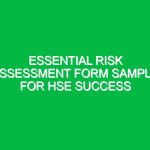Welcome, team! Today, we are going to discuss an important topic that directly impacts our health, safety, and overall well-being at work – Flu prevention. The flu can spread quickly in a workplace setting, affecting productivity and putting everyone at risk. By following some essential tips and best practices, we can minimize the chances of getting sick and create a healthier work environment for all of us.
The Importance of Flu Prevention
Flu, short for influenza, is a highly contagious respiratory illness caused by influenza viruses. It can lead to mild to severe symptoms, including fever, cough, sore throat, body aches, and fatigue. In some cases, it can even result in hospitalization or death, especially for vulnerable populations such as the elderly, young children, and individuals with underlying health conditions.
Preventing the flu is crucial not only for our own well-being but also for the safety of our colleagues and loved ones. By taking proactive measures to reduce the spread of flu in the workplace, we can protect ourselves and those around us from getting sick.
Best Practices for Flu Prevention
1. **Hand Hygiene**: Regularly wash your hands with soap and water for at least 20 seconds, especially after coughing, sneezing, or touching common surfaces.
2. **Use Hand Sanitizer**: When soap and water are not available, use an alcohol-based hand sanitizer to disinfect your hands.
3. **Cover Your Mouth and Nose**: When coughing or sneezing, use a tissue or your elbow to cover your mouth and nose to prevent the spread of respiratory droplets.
4. **Stay Home if Sick**: If you are experiencing flu-like symptoms, such as fever or body aches, stay home to prevent spreading the illness to others.
5. **Get Vaccinated**: Annual flu vaccines are an effective way to protect yourself and others from the flu. Make sure to get vaccinated each flu season.
Preventing Accidents and Promoting Safety
Flu prevention is not just about staying healthy; it also plays a crucial role in preventing accidents and promoting a safe working environment. When employees are sick with the flu, they may be less focused, fatigued, and prone to making mistakes that could lead to accidents or injuries. By taking steps to prevent the flu, we can maintain a high level of alertness and safety in our daily operations.
Regulations and Compliance
It is important to note that flu prevention is not just a matter of personal responsibility but also a regulatory requirement in many workplaces. OSHA guidelines emphasize the importance of maintaining a healthy work environment and preventing the spread of infectious diseases like the flu. By following these guidelines and company policies related to flu prevention, we can ensure compliance with safety standards and legal obligations.
Conclusion
As we conclude this Toolbox Talk on flu prevention, remember that each of us plays a vital role in creating a safe and healthy work environment. By following the best practices discussed today, we can minimize the risk of flu transmission, protect ourselves and our colleagues, and maintain productivity in our workplace. Thank you for your attention and commitment to staying healthy at work.


